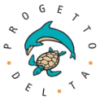
NAUTA's tasks in the LIFE project Del.Ta. Dolphins and Turtles protected
Started in 2003 the project aim was to realize urgent actions for the conservation of Loggerhead Turtle (Caretta caretta) and Bottlenose Dolphin (Tursiops truncatus), two species protected by international laws, due to threats by human activities.
Main target objective is to reduce interactions with fishing and the injuries or deaths that result from them in Sicily.
Pelagie Archipelago and the southern Sicily coast are the spots choosen to achieve fixed goals.
Within Del.Ta project Nauta has been assigned to realize an acoustic monitoring underwater system, the relative protocol of use and the final acoustic analysis to determine the presence of Bottlenose Dolphins in Pelagie Archipelago.
In particular, Bottlenose Dophins daily activities and their movements associated with interactions with fishing gears and pingers (acoustic deterrents that should keep dolphins out of nets and reduce bycatch) have been studied with the aim to find effective solutions for conservation. Passive acoustic methods have been used: bottom recorders and hydrophones, designed and manufactured at Nauta on purpose, have recorded and collected acoustic underwater sound data. Nauta signed a legal agreement with Provincia Regionale di Agrigento as sub-contractor to perform specific tasks as part of the overall Del.Ta Project, including the instrument manufacturing, the protocol of use, the operations at sea and the final acoustic analysis.
In particular, Bottlenose Dophins daily activities and their movements associated with interactions with fishing gears and pingers (acoustic deterrents that should keep dolphins out of nets and reduce bycatch) have been studied with the aim to find effective solutions for conservation. Passive acoustic methods have been used: bottom recorders and hydrophones, designed and manufactured at Nauta on purpose, have recorded and collected acoustic underwater sound data. Nauta signed a legal agreement with Provincia Regionale di Agrigento as sub-contractor to perform specific tasks as part of the overall Del.Ta Project, including the instrument manufacturing, the protocol of use, the operations at sea and the final acoustic analysis.
Research activities related to underwater acoustics covered the period between winter 2006 and winter 2007.
Acoustic sensors and instruments were deployed at the beginning of 2006 to return a year round data collection. Data were progressively analyzed.
Acoustic sensors and instruments were deployed at the beginning of 2006 to return a year round data collection. Data were progressively analyzed.
Professor Cristina Giacoma from Università di Torino was in charge for the overall scientific supervision of this LIFE project.
CIBRA (Interdisciplinary Center for Bioacoustics and Environmental Research), Università di Pavia, supported the underwater bioacoustic research carried out by Nauta.
Gianni Pavan, the Center scientific supervisor, with his team has solid experience in acoustic monitoring methods.
Nauta and CIBRA have already shared their experiences producing valuable results.
CIBRA hosted the instruments dedicated to archive and to analyze collected data.
Gianni Pavan, the Center scientific supervisor, with his team has solid experience in acoustic monitoring methods.
Nauta and CIBRA have already shared their experiences producing valuable results.
CIBRA hosted the instruments dedicated to archive and to analyze collected data.
A technical report has been produced to explain the available solutions for this data collection.
To reduce interaction between this research and standard at-sea operations carried out by commercial ships, the "bottom recorder" option has been chosen. Six (+2) recorders have been realized and will be periodically deployed in order to collect acoustic data in an evolving environment.
To reduce interaction between this research and standard at-sea operations carried out by commercial ships, the "bottom recorder" option has been chosen. Six (+2) recorders have been realized and will be periodically deployed in order to collect acoustic data in an evolving environment.
Data collection started in March 2006. Acoustic data are collected using RASP recorders, then moved to the centralized archive unit in Pavia.
All data are collected together with local temperature profile (form 0 to -40m) at deployment and at recovery. Acoustic data are collected in the 10Hz-16kHz band (compressed files), 10Hz - 22kHz (uncompressed files), 10Hz - 46kHz (uncompressed files) bands. Frequency bands are chosen in order to maximize recording duration or maximize acoustic fidelity or balance among these two requirements. Wideband recordings are tipically carried out during good weather conditions and forecast, when recovery can be easily made after a short period (24hrs tipically). Audio uncompressed recordings are made when a 72hrs good weather period is coming, while long compressed recordings are tipically programmed when a prolonged good weather condition is present. This example is not rigid and changes during at-sea operations.
All data are collected together with local temperature profile (form 0 to -40m) at deployment and at recovery. Acoustic data are collected in the 10Hz-16kHz band (compressed files), 10Hz - 22kHz (uncompressed files), 10Hz - 46kHz (uncompressed files) bands. Frequency bands are chosen in order to maximize recording duration or maximize acoustic fidelity or balance among these two requirements. Wideband recordings are tipically carried out during good weather conditions and forecast, when recovery can be easily made after a short period (24hrs tipically). Audio uncompressed recordings are made when a 72hrs good weather period is coming, while long compressed recordings are tipically programmed when a prolonged good weather condition is present. This example is not rigid and changes during at-sea operations.
All data were stored at CIBRA - Università di Pavia.
Acoustic data analysis were carried out by NAUTA with CIBRA collaboration.
The set of underwater recordings is available to general public and other researchers upon request.







